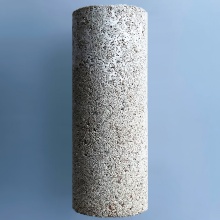Concrete is one of the most important building materials of our time. However, the burning of the required cement causes 8 % of the global climate-damaging CO2 emissions. The use of natural microbiological processes to consolidate aggregate into so-called bioconcrete represents a promising and potentially CO2-neutral alternative to cement-bound concrete. In bioconcrete, instead of cement, the aggregate is bound by calcium carbonate crystals precipitated by the activity of bacteria. The process is known as microbiologically induced calcite precipitation (MICP). Bioconcrete is already being applied in some areas of construction, such as sealing cracks in concrete, fixing sandy soils, and making bricks and tiles. To date, however, no processes exist by which bioconcrete can be used to manufacture large-format structural components. In our own preliminary work, test specimens of bioconcrete with a compressive strength of up to 50 MPa were produced. The best results in terms of cementation depth, homogeneity and strength were obtained with a production method in which the sand-bacteria mixture is flushed with the cementation solution under pressure. The cementation process took 3 to 5 days.
In this project, this manufacturing method will be optimized for upscaling and manufacturing of large-scale components. The cementation of test specimens will be accompanied by various analytical methods. The aim is to achieve the most homogeneous and deep cementation possible with optimum crystal morphology and distribution.










